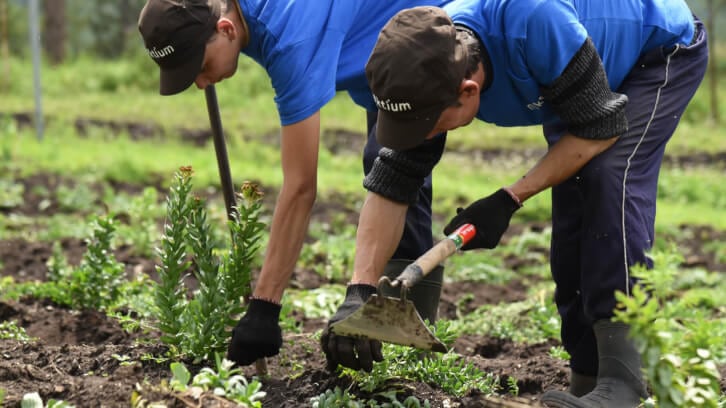Legally recognized compendia have expanded over time to include quality standards for botanical ingredients found in foods, dietary supplements and herbal medicines, but issues related to conservation status and species protection have not been addressed in botanical monographs or in the general chapters of the official United States Pharmacopeia (USP) until now.
A new study published in Economic Botany by medicinal plant and conservation experts led by Josef Brinckmann and Uwe Schippmann reviews the status of botanical species and suggests how the USP’s Botanical Dietary Supplements and Herbal Medicines Expert Committee could embed biodiversity protection into its standards.
“From the pharmacopeial or compendial perspective, biodiversity conservation is one of the pillars of environmental sustainability in the manufacturing life cycle for drugs, pharmaceutical excipients, foods and dietary supplements, which play a vital role in ensuring human well-being and overall public health,” the research team wrote.
Their investigation documented the botanical species listed in five United States Pharmacopeial Convention (USPC) compendia and assessed their conservation or protection statuses based on global and national conservation listings and biodiversity risk assessments.
Determining the strain on the species
Biodiversity loss caused by habitat destruction, invasive species, overexploitation and climate change poses a threat to medicinal plant availability and planetary health. The growing demand for standardized herbal products, particularly those defined by monograph, has also put a strain on sustainable harvesting, production and trade, the Economic Botany paper noted.
In the United States, retail sales of herbal dietary supplements reached $12.1 billion in 2022—reflecting steady growth with an average year-on-year increase of 5.6% over the last two decades.
“While only representing total sales of herbal supplements in one country, these data provide an indication of the growing botanical trade and thus the concern about sustainability and the need for conservation and protection of plants of commercial value worldwide,” the researchers wrote.
According to the Royal Botanic Gardens Kew Medicinal Plant Names Services (MPNS), there are 39,112 documented plant species of medicinal use globally. Most are harvested from wild populations, but a 2022 investigation by Brinckmann et al. shows that some 3,227 medicinal plant species have been brought out of the wild and into cultivation—a transition driven by economic viability and market demand rather than conservation threat status.
Of the total plants for medicinal use listed in the MPNS, this latest investigation identified 355 higher plant species officially listed in the pharmacopeias, after accounting for duplicate and unmatched names.
“Only 19 (5%) of the compendial species are CITES-listed, and 256 (72%) are obtained, at least, in part from cultivated sources,” according to the findings, referring to the Convention on International Trade in Endangered Species of Wild Fauna and Flora.
“However, this figure includes highly traded CITES-listed compendial species that are supplied to the market predominantly from wild-harvested sources, with relatively minor amounts obtained from cultivated sources, such as Hydrastis canadensis, Pygeum africana and Rhodiola rosea, among others.”
The researchers emphasize that even if a compendial species is commercially cultivated, preserving the biodiversity and genetic diversity of its wild populations remains essential. Sustainable agriculture and responsible wild collection practices are positioned as key to protecting these wild populations from overharvesting and genetic erosion.
This does not imply halting the sourcing of at-risk species or relying exclusively on cultivated sources but developing a sustainable supply chain that actively supports conservation efforts in the wild, Brinckmann noted.
“My experience, over the past couple of decades, shows that once a species is assessed as threatened and, in response, the harvesters implement sustainable resource management plans, then the biodiversity of the habitat area can be maintained, and rural communities can continue to earn their livelihoods from harvesting the plants,” he said.
“That’s much, much better than land use change, detrimental to biodiversity conservation, which can occur if the market turns away from the use of threatened species and rural harvesting communities lose a source of household income.”
The threat to dietary supplement species
The investigation specifically considered the supply of at-risk botanicals among the best-selling herbal supplement in the U.S. mainstream and natural product retail channels.
According to the American Botanical Council’s most recent Herb Market Report, U.S. sales of herbal supplements increased 4.4% in 2023 to reach an estimated $12.5 billion, indicating a rebound from the market dip that followed pandemic highs. The top seller in the mainstream channel was psyllium (Plantago ovata, Plantaginaceae), primarily in the cardiovascular and digestive health categories, and beet root registered the highest percentage growth in response to demand for energy support.
In the natural retail stores, turmeric led sales with a total of over $37 million, followed by CBD, elderberry, mushrooms (other) and ashwagandha. Here, barberry showed the greatest sales growth, nearly doubling to reach almost $8.4 million and largely prompted by a sharp increase in interest in berberine (one of its compounds) as #naturesozempic.
“We reported that 19 of the top 40 plant species used in dietary supplement products in the United States also showed up in our results for one or more of the assessments, e.g., as either CITES listed, or with an IUCN Global Threat Assessment, and/or a NatureServe Rank,” Brinckmann said. “For example, five compendial species that have top 40 sales are listed on CITES Appendix II: Hydrastis canadensis, Panax ginseng, Panax quinquefolius, Rhodiola crenulata and Rhodiola rosea.”
Regarding these CITES Appendix II listings, data from market research firm SPINS for the 52 weeks ending May 18, 2025 registered $1.4 million in goldenseal (Hydrastis canadensis) sales, $504.1 million in ginseng (Panax ginseng, Panax quinquefolius) sales and $12.8 million in rhodiola sales across grocery and vitamins and supplements in the U.S. natural, multi-outlet and convenience channels.
While most of the other top 40 best-selling species are listed as Least Concern by the International Union for Conservation of Nature (IUCN) Red List of Threatened Species, the investigation noted that a few commonly cultivated crops (Carica papaya, Curcuma longa and Zingiber officinale) have recently been categorized as Data Deficient. Meanwhile, NatureServe classifies Actaea racemosa, Hydrastis canadensis and Panax quinquefolius as vulnerable both within the United States and globally.
Brinckmann commented that the work extended beyond dietary supplement ingredients, revealing that various plant parts and their processed forms are often listed in multiple compendia for different uses. Ingredients in the Dietary Supplement Compendium (DSC) may also appear in other compendia—such as the Food Chemicals Codex (FCC), National Formulary (NF), United States Pharmacopeia (USP) or the Herbal Medicines Compendium (HMC).
Impacting the work of the USP in the next cycle
When developing new products, formulators assess both the quality and sustainability of each ingredient. While compendial monographs offer scientifically valid specifications for quality, information on species, conservation or protection status must be sourced separately.
Brinckmann and his co-authors noted that as a global public health leader and convener, USP is uniquely positioned to help stakeholders make more informed decisions about ethical, legal and sustainable sourcing and use of botanicals.
Their report lays out a roadmap for incorporating plant conservation measures directly into USP standards and resources for the organization’s 2025-2030 work cycle. It also uncovered the opportunity to develop a systematic and integrated nomenclature approach for consistent naming of compendial species across all five compendia of the USPC.
“This publication clearly shows the importance of the conservation status for compendial botanicals,” Thomas Brendler, an ethnobotanist and co-author on the paper, told NutraIngredients. “It will be my great pleasure as incoming chair of the new Botanical Dietary Supplements and Herbal Medicines Expert Committee to strive for the implementation of its recommendations in our workplan.”
To ensure that herbal products are not only safe and effective but also sustainably sourced, Brinckmann et al. suggest that the expert committee consider the following:
- Monograph Submissions: Sponsors should provide conservation status information using the methodology described in the paper.
- Threatened Species: A risk mitigation strategy, including sustainable production methods, should be required.
- General Chapters: Add a section on conservation status in General Chapter <2030> Supplemental Information for Article of Botanical Origin, which can serve as a repository for such data.
- Monograph Notes: Include auxiliary information on conservation status in the Definition section with a link to the relevant General Chapter.
- DSC Supplementary Information: Use this as an additional repository for conservation information.
- Nomenclature Consistency: Develop a systematic and integrated approach for naming compendial species.
- Updates: Revise monograph titles and Latin binomials for botanical articles using the recommended nomenclature.
The work also aligns with the 2022 Convention of Biological Diversity and the recent draft of the 2025–2034 WHO Strategy for Traditional Complementary and Integrative Medicine (TCIM), which recognize the connection between biological and cultural diversity and promote the integration of ecological perspectives into healthcare, resource conservation and the responsible use of natural medicines.
“Personally, I am delighted that the USPC will consider amendments to the relevant general chapter(s) and monographs to include, in the future, educational information regarding the conservation and protection status of compendial species,” Brinckmann said.
Source: Economic Botany. doi: 10.1007/s12231-025-09636-2. “Conservation and Protection Status of United States Pharmacopeial Convention’s Compendial Articles of Botanical Origin”. Authors: Josef A. Brinckmann et al.



